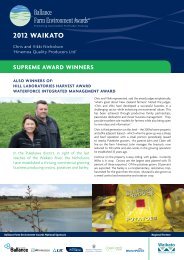Dairy's role in sustaining New Zealand - Fonterra
Dairy's role in sustaining New Zealand - Fonterra
Dairy's role in sustaining New Zealand - Fonterra
You also want an ePaper? Increase the reach of your titles
YUMPU automatically turns print PDFs into web optimized ePapers that Google loves.
Table 5 Indirect impacts 2010<br />
Percentage deviation <strong>in</strong> value added from BAU levels, selected <strong>in</strong>dustries<br />
Industry Type Impact<br />
Agricultural services Supply<strong>in</strong>g 0.09%<br />
Fertilizer Supply<strong>in</strong>g -0.2%<br />
Retail Household expenditure 0.7%<br />
Real estate Household expenditure 1.1%<br />
Residential property Household expenditure 0.03%<br />
Schools Government 1.1%<br />
Hospitals Government 1.3%<br />
Police Government 0.8%<br />
Apple and Pear Compet<strong>in</strong>g export -3.0%<br />
Sheep and Beef Compet<strong>in</strong>g export -0.4%<br />
Textiles Compet<strong>in</strong>g export -1.3%<br />
Source: NZIER<br />
3.2.3 Macroeconomic effects<br />
The national results follow naturally from the direct and <strong>in</strong>direct impacts described above. We<br />
focus on the key macroeconomic variables described <strong>in</strong> section 2.5: employment and Gross<br />
Domestic Product (GDP), as well as consumption, which is a measure of NEB (how ‘well off’<br />
we are).<br />
The NEB/welfare ga<strong>in</strong> for <strong>New</strong> <strong>Zealand</strong>, proxied by private and public consumption is an<br />
<strong>in</strong>crease of 1.2%. That represents an extra $1.2 billion of goods consumed <strong>in</strong> <strong>New</strong> <strong>Zealand</strong>,<br />
relative to the situation if the price of milk solids had rema<strong>in</strong>ed constant. This equates to over<br />
$270 of additional spend<strong>in</strong>g per man, woman and child <strong>in</strong> <strong>New</strong> <strong>Zealand</strong> due to the $1/kg<br />
price <strong>in</strong>crease.<br />
The change <strong>in</strong> real GDP of 0.24%, or $395 million, represents the <strong>in</strong>crease <strong>in</strong> the value of<br />
goods and services produced <strong>in</strong> the economy. The benefits arise from the <strong>in</strong>creased flows of<br />
<strong>in</strong>come to farmers be<strong>in</strong>g distributed throughout the economy via supply<strong>in</strong>g <strong>in</strong>dustries and<br />
government and household spend<strong>in</strong>g.<br />
The NEB ga<strong>in</strong> is larger than the GDP ga<strong>in</strong> for two reasons:<br />
• An <strong>in</strong>crease <strong>in</strong> the price of dairy exports improves <strong>New</strong> <strong>Zealand</strong>’s terms of trade. An<br />
<strong>in</strong>crease <strong>in</strong> the terms of trade allows us to consume more of our GDP.<br />
• The assumed <strong>in</strong>crease <strong>in</strong> demand for dairy exports causes a currency appreciation that<br />
leads to a reduction <strong>in</strong> the domestic currency value of <strong>New</strong> <strong>Zealand</strong>’s <strong>in</strong>terest repayments<br />
on foreign debt. This improves <strong>New</strong> <strong>Zealand</strong>ers’household purchas<strong>in</strong>g power and allows<br />
greater consumption of goods and services. Under different assumptions about the<br />
mechanisms of foreign <strong>in</strong>vestment, this contribution is dampened (see Appendix C).<br />
Overall, the <strong>in</strong>creased milk solids price draws wealth <strong>in</strong>to the country via dairy exports and<br />
that leads to an <strong>in</strong>crease <strong>in</strong> <strong>New</strong> <strong>Zealand</strong>’s wealth and, thus, our liv<strong>in</strong>g standards.<br />
The impact on export compet<strong>in</strong>g <strong>in</strong>dustries is negative because of the appreciation of our<br />
currency. However, that same appreciation allows us to buy more from overseas as can be<br />
seen by the rise <strong>in</strong> imports and private consumption (see Table 6).<br />
Dairy’s <strong>role</strong> <strong>in</strong> generat<strong>in</strong>g growth<br />
15
















